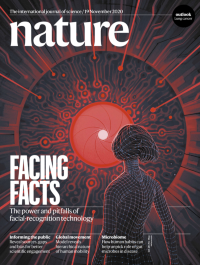Volume 587
-
No. 7835 26 November 2020
Catching the raysThe Sun generates the vast majority of its energy from the fusion of hydrogen to form helium in a process called the proton–proton chain. But a small amount of its energy was thought to come from a secondary fusion process catalysed by carbon, nitrogen and oxygen, known as the CNO cycle. In this week’s issue, the Borexino Collaboration presents results that offer the first direct experimental evidence for the CNO cycle occurring in the Sun. The researchers used the Borexino detector (pictured on the cover) at the INFN Gran Sasso National Laboratories near L’Aquila, Italy, to detect neutrinos emitted as a result of the cycle. The results allowed the team to confirm that the CNO cycle contributes to about 1% of the Sun’s energy, and could offer fresh ways to probe the elemental composition of the Sun’s core.
Nature Outlook
-
No. 7834 19 November 2020
Facing factsFacial-recognition systems have long been used at airport borders and on smartphones, but they are increasingly extending their reach into both public and private spaces. In this special issue, Nature probes the power — and the pitfalls — of the technology. One News Feature examines the inaccuracies and biases displayed by current systems. Another feature lifts the lid on ‘smart cities’ and how a lack of regulation and oversight could erode civil liberties. A third article discusses the growing concerns over the ethics of research studies in facial recognition. As governments and institutions seek to capitalize on this burgeoning technology, it is clear the field must take action to prevent abuse.
Nature Outlook
-
No. 7833 12 November 2020
Patterns in evolutionAlthough genome sequencing is increasingly routine for humans, it remains much less common in most other species, and only a small portion of the diversity of life is represented in genomic databases. In this issue, three papers take steps to redress the balance, exploring uncharted branches of vertebrate evolution. In one paper, Guojie Zhang and colleagues from the Bird 10,000 Genomes Project compare 363 genomes representing more than 90% of avian families, including 267 newly sequenced bird species. In another paper, Elinor Karlsson and her colleagues in the Zoonomia Project describe their analysis of 240 genomes representing more than 80% of placental mammal families, including 122 newly sequenced species. To analyse these massive data sets, both teams used new software called Progressive Cactus, which is described by Benedict Paten and co-workers in the third paper. The software can align thousands of genomes spanning hundreds of millions of years of evolution by reconstructing ancestral genomes using cactus graphs. The cover image reflects this process, using stylized mathematical graphs to highlight the software used and create constellations of some species sequenced in this week’s issue.
-
No. 7832 5 November 2020
Atoms in focusIn recent years, advances in cryo-electron microscopy (cryo-EM) have enabled the technique to resolve biomolecules in excellent detail. But with typical resolutions limited at around 3 ångströms, cryo-EM still lags behind X-ray crystallography in understanding the finer elements. Two papers in this week’s issue change that, as they use single-particle cryo-EM to achieve structural analyses of proteins at atomic resolution. In one paper, Sjors Scheres, Radu Aricescu and their colleagues report structures of apoferritin (pictured on the cover) and the GABA-A receptor at around 1.22 Å and 1.7 Å, respectively, using a new electron source, energy filter and camera. In the other paper, Holger Stark and co-workers use a newly developed cryo-EM to produce a structure of apoferritin at a resolution of around 1.24 Å. Both approaches should help pave the way for the technique to be used more widely in structure-based drug design.
Spotlight




